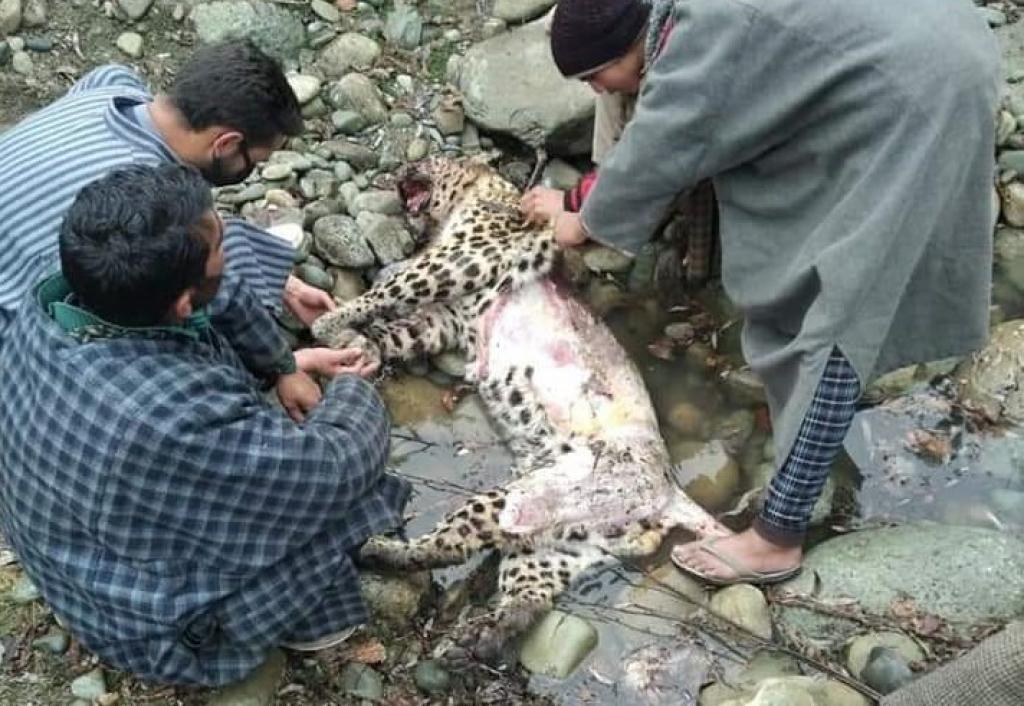‘Nobody Knows Their Number’: ‘Operation Leopard’ Getting Wild in Kashmir

Adil Amin Akhoon is the Managing Editor at The Mountain…
As the valley remains oblivious about the number of wild cats prowling around habitations, the frequent attacks are only giving sleepless nights to people.
There was nothing baleful in the air when Mehraj Din Reshi retired to bed on June 22 after checking flock in his fold. But in the rising rumpus of the man-wild conflict in the valley, the man failed to spot a sneaked beast in his courtyard eyeing his sheep that night.
The nocturnal attack came when Reshi’s Rembalpora village in the Kunzer area of north Kashmir’s Baramulla district was fast asleep.
By the daybreak, the slaughter in the shed was on show drawing dozens from their beds. Scores of simpletons were shocked to see a stack of dead sheep smeared with their own blood.
Before running back to the wilderness, a leopard had killed 20 sheep and injured four others.
“I don’t know why these leopard attacks are suddenly increasing in Kashmir now,” mournful Mehraj said.
Support Our Journalism
You are reading this because you value quality and serious journalism.
But, serious journalism needs serious support. We need readers like you to support us and pay for making quality and independent journalism more vibrant.
“But since this has now become a deadly routine, it calls for an emergency response.”

Wild attacks are surging in the second wave of coronavirus across the valley. Experts blame the surging street strays, the emergence of green zones in urban pockets and annihilation of the wild habitat due to deforestation for these attacks.
Only in the year 2020-21, 307 leopards were captured after venturing into the human habitations in Kashmir.
As the “most dangerous” animal, leopard—according to the wildlife department data—has killed 229 people, mainly children, in the last 15 years across Jammu and Kashmir. About 3,390 persons were injured in these attacks between 2006 and 2019.
Out of five attacks, at least one happened at the victim’s home and mostly during daylight hours, according to the Predator Alert – a report by Jammu and Kashmir’s department of wildlife protection.
“Yes, the population of leopards has grown but we don’t know the full figure,” said Suresh Kumar Gupta, J&K’s chief wildlife warden. “The ban on hunting is partly responsible for this surge.”
Hunting in woods is no longer the same vocation—as the shots now supposedly alert the counterinsurgent grid. Kashmir jungles over the years became battlegrounds for the militant-military clashes. And the fear of consequences, many say, is mostly keeping poachers away from the forests, thus giving a field day to the growing tribe of wild cats.
But as the valley remains oblivious about the number of beasts prowling around, people fear more attacks.
Sensing the anguish, the union territory managers lately decided to conduct the first leopard census to ascertain the exact beast figure in Kashmir.
The outcry started when the 80-kg, full-grown leopardess snatched four-year-old Adda Mir from her home in Budgam district’s Ompora area on June 4 this year.

The next morning the mauled body of the girl was found in the nearby nursery — set up by the administration and “later on failed to maintain it”. Before the shocking incident, the locals had reported two leopard sightings in the area. The perilous prowling, however, failed to draw a desirable official response.
But after the Kashmiri girl became the latest victim of the man-wild conflict, the wildlife department sent hunters to kill or capture the man-eater.
“Over 60 officials of wildlife department including hired local hunters camped in small numbers at various locations using all means to trace the man-eater,” said Bashir Ahmad, an official who monitored the operation leopard.
“We got many calls from the locals of the adjoining area about the presence of leopard in their vicinity. The number of leopards active in the area was alarming. While the man-eater gave us slips, we ended up rescuing four other leopards.”
The operation leopard saw the hunters—armed with tranquillizer guns, and guided by drones—laying special traps and cages.
“The nursery turned full-grown forest had alarmed us long back because it had become a bastion of beasts,” said Amir Ahmed, a local resident from Ompora.
“But wildlife officials only chopped down trees there when the leopard did the damage.”

Before Ompora, many wild incidents were reported in Kashmir where people were either mauled to death or injured by leopards.
On May 21, 2021, at least eight people were badly injured in a leopard attack in south Kashmir’s Kulgam district. The angry mob would go after the beast and slay it in public glare.
Similarly, in north Kashmir, people reported multiple encounters with the wild cats, sometimes leaving them injured or killing their livestock.
“At least, four leopard attacks are reported here every year,” said Farooq Ahmed, a resident of Kupwara’s Lalpora village.
In the same northern belt bordered by dense woods, a couple was injured by a leopard on February 15 this year. Soon the neighbours rushed to the spot and rescued them.
“Leopard attack cases are increasing,” observed Amir Nazir, a local compounder in Handwara. “At least, twice in a month now, I get calls for bandaging the wounds of man-wild conflict victims.”
But despite the discernable rise in leopard attacks in Kashmir, a wildlife official said, “Nobody knows their number.”
Mountain Ink is now on Telegram. Subscribe here.
Become Our Ally
To help us strengthen the tradition of quality reading and writing, we need allies like YOU. Subscribe to us.











